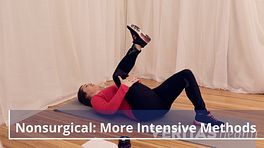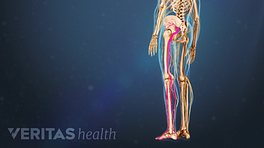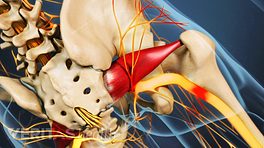Walking is a surprisingly effective approach for relieving sciatic pain because regular walking spurs the release of pain-fighting endorphins and reduces inflammation. On the other hand, a poor walking posture may aggravate your sciatica symptoms.1
Walking is a simple, low-impact exercise that can help relieve your sciatica.
Watch: Video: 2 Walking Tips to Avoid Sciatica Pain
To help improve your form and avoid sciatica pain, here are 2 walking tips.
1. Shorten your stride to protect your sciatic nerve
Incorrect walking posture can compress your lumbar discs2 and irritate the sciatic nerve. In general, the initial contact of the foot, length of the stride, and the speed of walking need to be considered to avoid sciatica pain.
Follow these pointers to correct your steps:
- Don’t reach with your toes. Land between your midfoot and heel, then gently roll onto your toes and push off into the next stride. This type of initial foot contact will naturally shorten your stride because it is difficult to roll your foot when it’s far from your body.
- Slow down. A slower pace typically means shorter steps. You should be able to comfortably hold a conversation while walking.
When you walk using correct posture, the core abdominal and back muscles, as well as the hip, thigh, and leg muscles work in sync to prevent stresses on the spine.
See Techniques for Effective Exercise Walking
2. Engage your core muscles to support your spine

4 Easy Core Exercises for Sciatica Relief
(larger view)
Actively engaging your abdominal muscles protects your sciatic nerve roots by minimizing pressure on your spine. The stress and fatigue of these muscles increase considerably when incorrect walking is used.2 A weak core, in turn, may cause additional back pain and aggravate your sciatica symptoms.
Here’s how to use your abdominal muscles correctly:
- Stand upright. Keep your head and shoulders tall and focus on a spot in the distance.
- Focus on your breathing. Rhythmic breathing helps keep the mind focused and alert while walking.
- Tuck in your stomach. Pull your stomach slightly toward your body for the duration of your walk and keep a comfortable pace; it can be challenging to engage your abdominal muscles if you walk too fast.
Do not strain the abdominal muscles by tucking in too hard or if it feels uncomfortable.
See How Your Walking Posture Affects Your Sciatic Nerve
Other simple activities to add on to your walking routine
You can also try one or more of the following exercises to improve your overall walking experience:
- Take breaks and perform deep breathing. Sit down for a few minutes and take deep breaths. A slow, rhythmic inhale-exhale exercise reduces stress, improves attention, and releases endorphins or feel-good hormones that help reduce pain.3
- Stretch your hamstring and hip flexor muscles daily. Relieving tightness in your hamstrings and hip flexors, such as the iliopsoas can help reduce stresses on your lower back and improve sciatica pain.
While walking or performing any exercise, understand your pain limits and pay close attention to your body. Stop any activity that causes or aggravates your pain.
If walking isn't for you, try one of these low-impact aerobic exercise options:
- Water therapy
- Stationary bike
- Elliptical trainer
- Step machine
Staying active and exercising consistently can help improve overall health and prevent chronic pain.
Learn more:
Everyday Activities to Relieve Sciatica
Sciatica Exercises for Sciatica Pain Relief
References
- 1.Khan MS, Charissis V, Sakellariou S. Exploring the Development Requirements for Virtual Reality Gait Analysis. Multimodal Technologies and Interaction. 2019;3(2):24. doi:10.3390/mti3020024
- 2.Kuai S, Liao Z, Zhou W, et al. The Effect of Lumbar Disc Herniation on Musculoskeletal Loadings in the Spinal Region During Level Walking and Stair Climbing. Med Sci Monit. 2017;23:3869–3877. Published 2017 Aug 10. Available at: https://www.ncbi.nlm.nih.gov/pmc/articles/PMC5562184/
- 3.Ma X, Yue ZQ, Gong ZQ, et al. The Effect of Diaphragmatic Breathing on Attention, Negative Affect and Stress in Healthy Adults. Front Psychol. 2017;8:874. Published 2017 Jun 6. Available at: https://www.ncbi.nlm.nih.gov/pmc/articles/PMC5455070/








